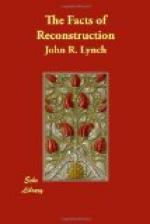Shortly after the adjournment of the convention Senator Alcorn had another convention called which nominated a ticket, composed exclusively of Republicans, with himself at its head for Governor. The Democrats at their convention endorsed the Alcorn ticket. While it would seem that this action on the part of the Democrats ought to have increased Alcorn’s chances of success, it appears to have been a contributory cause of his defeat. Thousands of Republicans who were in sympathy with the movement, and who would have otherwise voted the Alcorn ticket, refused to do so for the reason that if it had been elected the Democrats could have claimed a victory for their party. On the other hand, both tickets being composed exclusively of Republicans, thousands of Democrats refused to vote for either, while some of them voted the Ames ticket. At any rate the election resulted in the success of the Ames ticket by a majority of more than twenty thousand. The regular Republicans also had a large majority in both branches of the Legislature.
[Illustration: Hon. B.K. Bruce United States Senator, 1875-1881]
CHAPTER VII
MISSISSIPPI SENDS B.K. BRUCE TO THE UNITED STATES SENATE
As soon as the result of the election was known, the candidacy of B.K. Bruce, for United States Senator to succeed Senator Ames, was announced. Ames’ term as Governor was to commence the first Monday in January, 1874. His term as Senator would expire March 4, 1875. Upon assuming the duties of Governor he had been obliged to tender his resignation as Senator; thus it devolved upon the incoming legislature to elect a Senator to serve out the unexpired term, as well as for the full term of six years. Bruce’s candidacy was for the full term.
The secret of Mr. Bruce’s positive refusal to allow his name to be used for the Lieutenant-Governorship, which would have resulted in making him Governor, was now revealed. He had had the Senatorship in mind at the time, but, of course, no allusion was made to that fact. As between the Senatorship and the Governorship he chose the former, which proved to be a wise decision, in view of subsequent events. It was soon developed that he was the choice of a large majority of the Republican members of the Legislature, white as well as colored. His nomination by the party caucus, therefore, was a foregone conclusion. Before the legislature met, it had been practically settled that Mr. Bruce should be sent to the Senate for the long term and Ex-Superintendant of Education, H.R. Pease, should be elected to serve out the unexpired term of Governor-elect Ames.
This slate was approved by the joint legislative caucus without a hitch and the candidates thus nominated were duly elected by the Legislature,—not only by the solid Republican vote of that body, but the additional vote of State Senator Hiram Cassidy, Jr., who had been elected as a Democrat.




